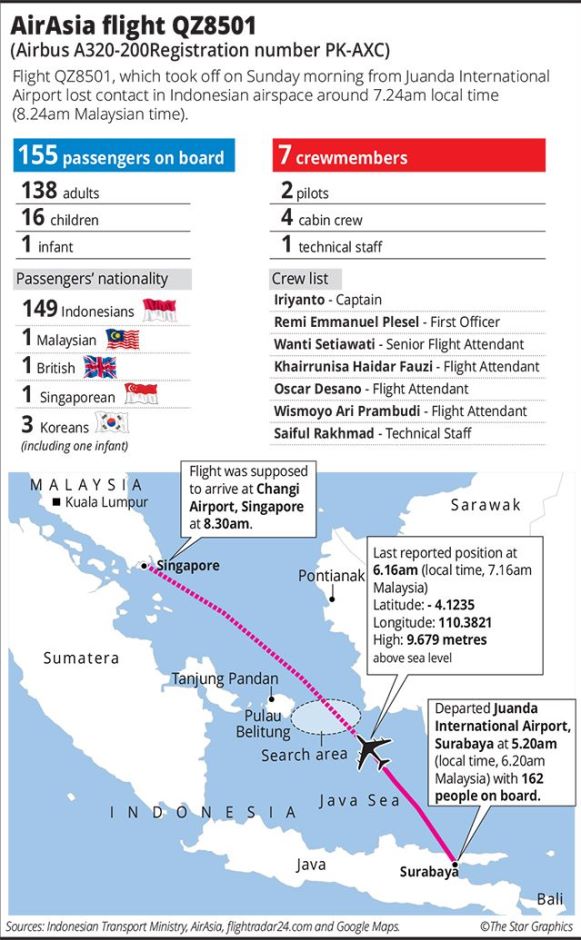Missing flight QZ8501: Bad weather seen as likelier culprit than foul play

The facts are murky but there is a high chance that Indonesia AirAsia Flight QZ8501 crashed in the Java Sea amid bad weather, about an hour after it left Surabaya for Singapore with 155 passengers and seven crew members on board.
The authorities have not said so officially but foul play seems to have been ruled out.
The Airbus 320 jet, which took off from Surabaya at 5.20am local time was cruising at 32,000 feet about an hour later when the pilots informed air traffic controllers that they were taking the plane up to 38,000 feet to avoid a cloud.
Six minutes later, contact was lost.
An official from Indonesia's meteorological agency said it was raining slightly in the Belitung and Pontianak areas when the plane was estimated to be flying through the vicinity, with thick cumulonimbus clouds as high as 45,000 feet.
"In general, cumulonimbus is quite dangerous for aviation activities because it causes thunderstorms and heavy rain," she said.
Cumulonimbus clouds are capable of producing lightning and other dangerous weather conditions, such as gusts, hail and occasional tornadoes.
Exactly what happened to QZ8501 remains a mystery but there are several possibilities, experts said.
Pilots whom The Straits Times spoke to, including those who have flown the Surabaya-Singapore sector, said that when bad weather hits, the first thing is to try and fly around the cloud.
But this is not always possible, for example, if the bad patch is significantly wide or there are too many planes in the area.
The other option is to fly above the cloud but this can be a problem because, if the plane goes too high, other issues can crop up.
Said an experienced A320 pilot: "Thirty-eight thousand feet is still within the safe range but it is very high and, up there, you are pushing the limits of the plane."
Under severe pressure, the engine can stall, he said. When this happens amid bad weather, multiple problems can occur.
Mr Paul Yap, who heads Temasek Polytechnic's aviation and aerospace department, said: "One thing leads to another. Bad storms and turbulence can cause systems, for example the speed indicator, to fail or the auto pilot to stop working without the pilots realising it.
"Things can go wrong very quickly. One minute the pilot is in control, the next minute he is not. In many cases, they are able to recover but, unfortunately, sometimes they are not."
While planes rarely go down because of bad weather, worsening climate conditions are a concern for travellers.
Mr Yap said: "Does this mean flying has or will become less safe? I don't think we can say that. Of course, flying in bad weather carries more risk than cruising amid clear skies but it's the same for driving as well... And I dare say that the chaps sitting in the cockpit are more capable of handling an emergency, compared with car drivers."
Statistically, flying has become safer. From 90 air accidents in 2009, there were 81 last year. The improvement comes even as the number of travellers increased from 2.2 billion in 2005 to 3.1 billion last year.
However, about 700 people have died from air disasters this year, which is higher than the annual average of 517 fatalities in the past five years, according to data compiled by Iata. This is mainly due to high-profile tragedies this year, including the disappearance of Malaysia Airlines Flight MH370 in March and the shooting down of another Malaysia Airlines flight in July.
Efforts are under way to study how airlines can better cope with bad weather conditions, said Mr Hsin Chen Chung, director of Nanyang Technological University's Air Traffic Management Research Institute. Extreme weather conditions are becoming more frequent and intense, he said.
Researchers at his institute are working on two weather-related research projects.
Said Mr Hsin: "The focus is to see how we can improve the industry's ability to handle weather conditions... This includes being able to not just better forecast weather conditions but also to use the data in a meaningful way."

This article was first published on December 29, 2014.
Get a copy of The Straits Times or go to straitstimes.com for more stories.
